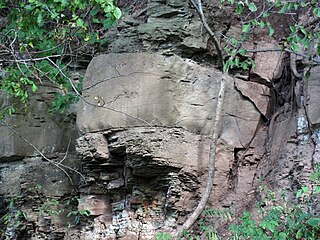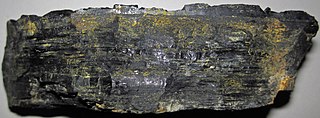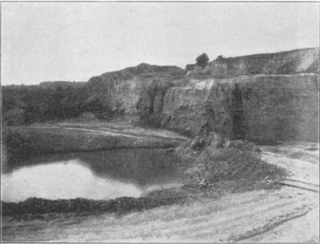
The Morrison Formation is a distinctive sequence of Upper Jurassic sedimentary rock found in the western United States which has been the most fertile source of dinosaur fossils in North America. It is composed of mudstone, sandstone, siltstone, and limestone and is light gray, greenish gray, or red. Most of the fossils occur in the green siltstone beds and lower sandstones, relics of the rivers and floodplains of the Jurassic period.

The Permian Dunkard Group (Pd) is an area of rock, Early Permian in age, in the south of Ohio, southwestern Pennsylvania, West Virginia and the hilltops of the Georges Creek Basin of Maryland. In Ohio, it is found primarily in Washington County. It is notable for being one of the few areas of Permian sediment east of the Mississippi River. In addition, it is the youngest surface rock in the state of Ohio.

The Ordovician Reedsville Formation is a mapped surficial bedrock unit in Pennsylvania, Maryland, Virginia, West Virginia, and Tennessee, that extends into the subsurface of Ohio. This rock is a slope-former adjacent to the prominent ridge-forming Bald Eagle sandstone unit in the Appalachian Mountains. It is often abbreviated Or on geologic maps.

Wills Creek Formation is a mapped Silurian bedrock unit in Pennsylvania, Maryland, Virginia, and West Virginia.
The Devonian Mahantango Formation is a mapped bedrock unit in Pennsylvania, West Virginia, and Maryland. It is named for the North branch of the Mahantango Creek in Perry and Juniata counties in Pennsylvania. It is a member of the Hamilton Group, along with the underlying the Marcellus Formation Shale. South of Tuscarora Mountain in south central Pennsylvania, the lower members of this unit were also mapped as the Montebello Formation. Details of the type section and of stratigraphic nomenclature for this unit as used by the U.S. Geological Survey are available on-line at the National Geologic Map Database.

The Pennsylvanian Pottsville Formation is a mapped bedrock unit in Pennsylvania, western Maryland, West Virginia, Ohio, and Alabama. It is a major ridge-former in the Ridge-and-Valley Appalachians of the eastern United States. The Pottsville Formation is conspicuous at many sites along the Allegheny Front, the eastern escarpment of the Allegheny or Appalachian Plateau.

The Glenshaw Formation is a mapped sedimentary bedrock unit in Pennsylvania, Maryland, West Virginia, and Ohio, of Pennsylvanian age. It is the lower of two formations in the Conemaugh Group, the upper being the Casselman Formation. The boundary between these two units is the top of the marine Ames Limestone. The Conemaugh Group overlies the Upper Freeport coal bed of the Allegheny Formation and underlies the Pittsburgh coal seam of the Monongahela Group.

The Bluefield Formation is a geologic formation in West Virginia. It preserves fossils dating back to the Mississippian subperiod of the Carboniferous period. Sediments of this age formed along a large marine basin lying in the region of what is now the Appalachian Plateau. The Bluefield Formation is the lowest section of the primarily siliciclastic Mauch Chunk Group, underlying the Stony Gap Sandstone Member of the Hinton Formation and overlying the limestone-rich Greenbrier Group.
The Williamsport Sandstone is a sandstone geologic formation in West Virginia, Virginia, Pennsylvania, and Maryland. the formation includes the Cedar Creek Limestone member. Near Cumberland, Maryland it includes the Cedar Creek Limestone member. It preserves fossils dating back to the Silurian period.

The Washington Formation is a coal, sandstone, and limestone geologic formation located in Ohio, Pennsylvania and West Virginia. It dates back to the Lower Permian period, with its base at or near the Permian/Carboniferous boundary. The Washington formation and the Dunkard Group as a whole was deposited at a time when the continents were in the process of forming the "Super Continent" Pangaea as well as a gradual drop in sea levels. The result during this period was coals being thinner and impure with high ash content. The limestones found with in the formation are exclusively freshwater deposits.
The Albemarle Group is a geologic group in North Carolina composed of metamorphosed mafic and felsic volcanic rock, sandstone, siltstone, shale, and mudstone. It is considered part of the Carolina Slate Belt and covers several counties in central North Carolina. It preserves fossils dating back to the Ediacaran period in the Floyd Church member.

The Patapsco Formation is a geologic formation of varigated clays, sandy clays, and sand in Virginia, the District of Columbia, Maryland, Delaware, Pennsylvania, and in the subsurface of New Jersey. It preserves fossils such as plants and molluscs dating back to the Cretaceous period.
The Java Formation is a geologic formation in Kentucky, New York, Ohio, Pennsylvania, Tennessee, Virginia, West Virginia. It preserves fossils dating back to the Devonian period. The formation comprises the Pipe Creek Shale, Wiscoy Sandstone Member in New York, and Hanover Shale Member except in Tennessee.
The Tallahatta Formation is a geologic formation found on the surface in Alabama, Florida, Georgia, and Mississippi. It is also located in the subsurface of Kentucky. The Tallahatta formation is part of the Claiborne Group and contains four members: the Basic City Shale in Mississippi, the Holy Springs Sand Member in Mississippi, the Meridian Sand Member in Alabama and Mississippi, and the Neshoba Sand Member in Mississippi. It preserves fossils dating back to the Paleogene period, specifically the Eocene.
The Troublesome Formation is a geologic formation in Colorado. It preserves fossils dating back to the Neogene period. It consists of Pale shades of pink, tan, gray, green, and white interbedded siltstone and mudstone, less abundant arkosic sandstone and conglomerate, and sparse limestone and altered crystal-vitric ash and tuff; generally poorly consolidated. It includes atypical deposits containing abundant pink, granitic cobbles and boulders along the western parts of the outcrop in the west-central and southwestern parts of the Granby Quadrangle, Fossil mammals from three sites indicate a late Oligocene age.

The Renton Formation is a geologic formation in Washington (state) within the Puget Group. It preserves fossils dating back to the Paleogene period.
The Monteith Formation is a geologic formation of Early Cretaceous (Valanginian) age in the Western Canada Sedimentary Basin that consists primarily of sandstone. It is present in the northern foothills of the Canadian Rockies and the adjacent plains in northeastern British Columbia and west-central Alberta.
The Scremerston Formation is a geologic formation in England. It preserves fossils dating back to the Carboniferous period.
The Waynesboro Formation is a limestone, dolomite, and sandstone geologic formation in Virginia, Maryland, Pennsylvania and West Virginia. In some areas it is composed of limestone and dolomite. The Waynsboro Formation is one of the formations that make up the Shenandoah Valley. It dates back to the Cambrian period and is not considered fossiliferous.
Toad Formation, Grayling Formation, and Toad-Grayling Formation are obsolete names for the strata of the Early to Middle Triassic Doig and Montney Formations. They were applied in the foothills and Rocky Mountains of northeastern British Columbia, on the western edge of the Western Canada Sedimentary Basin. Although the names are considered obsolete, their usage persists.









